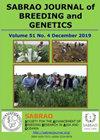GENETICS OF CERCOSPORA LEAF SPOT RESISTANCE IN MUNG BEAN
IF 1.6
Q3 PLANT SCIENCES
引用次数: 0
Abstract
Pulses are notably good nutritive complements of carbohydrate-rich staple diets, such as, wheat, maize, and rice. Mung bean is an essential pulse crop with different proteins and antioxidants proven beneficial for health. The yield of mung bean in Pakistan is comparable to the world average, but overall production is low because of several biotic and abiotic factors. Cercospora leaf spot (CLS) is one of mung bean’s most damaging diseases, limiting its productivity, causing significant losses in yield and an overall gap in production. The presented investigation progressed to comprehending the genetics of resistance to CLS in mung bean. A minicore set of 293 mung bean genotypes developed and maintained by the World Vegetable Center, Taiwan, served as samples in the study. Observed CLS attacks occur during flowering and reduce the yield by decreasing the number of pods per plant. The genetics to resistance against CLS has a single recessive gene controlling it; hence, homozygous recessive plants will be CLS-resistant. Therefore, single gene transfer methods, such as, backcross breeding, are recommendable for incorporating CLS resistance in high-yielding mung bean genotypes.绿豆尾孢菌叶斑病抗性的遗传研究
豆类是富含碳水化合物的主食(如小麦、玉米和大米)的良好营养补充。绿豆是一种重要的豆类作物,含有不同的蛋白质和抗氧化剂,对健康有益。巴基斯坦的绿豆产量与世界平均水平相当,但由于一些生物和非生物因素,总体产量较低。Cercospora叶斑病(CLS)是绿豆最具破坏性的疾病之一,它限制了绿豆的生产力,导致产量显著损失和产量总体缺口。本研究对绿豆抗CLS的遗传机制进行了深入的研究。由台湾世界蔬菜中心开发和维护的293种绿豆基因型的小型矿石作为研究样本。观察到的CLS攻击发生在开花期间,并通过减少单株荚的数量来降低产量。对CLS抗性的遗传具有控制CLS的单隐性基因;因此,纯合隐性植物将具有CLS抗性。因此,建议采用单基因转移方法,如回交育种,在高产绿豆基因型中引入CLS抗性。
本文章由计算机程序翻译,如有差异,请以英文原文为准。
求助全文
约1分钟内获得全文
求助全文
来源期刊

Sabrao Journal of Breeding and Genetics
农林科学-奶制品与动物科学
CiteScore
1.90
自引率
50.00%
发文量
63
期刊介绍:
The SABRAO Journal of Breeding and Genetics is an international journal of plant breeding and genetics research and was first published in 1969. It is the official publication of the Society for the Advancement of Breeding Research in Asia and Oceania (SABRAO).
Its objectives are to: promote the international exchange of research information on plant breeding and genetics, by describing new research findings, or ideas of a basic or practical nature; and be a medium for the exchange of ideas and news regarding members of the Society.
The Journal gives priority to articles that are of direct relevance to plant breeders and with emphasis on the Asian region. Invited for publication are research articles, short communications, methods, reviews, commentaries, and opinion articles. Scientific contributions are refereed and edited to international standards.
The journal publishes articles for SABRAO members mainly. The Journal preferred strongly that at least one author should be a current member of the Society. Non-members may also publish in the journal.
 求助内容:
求助内容: 应助结果提醒方式:
应助结果提醒方式:


